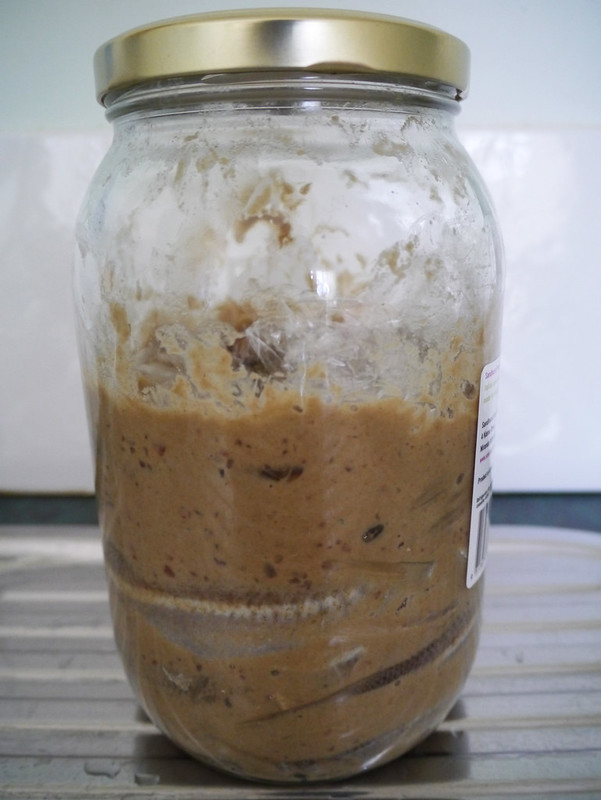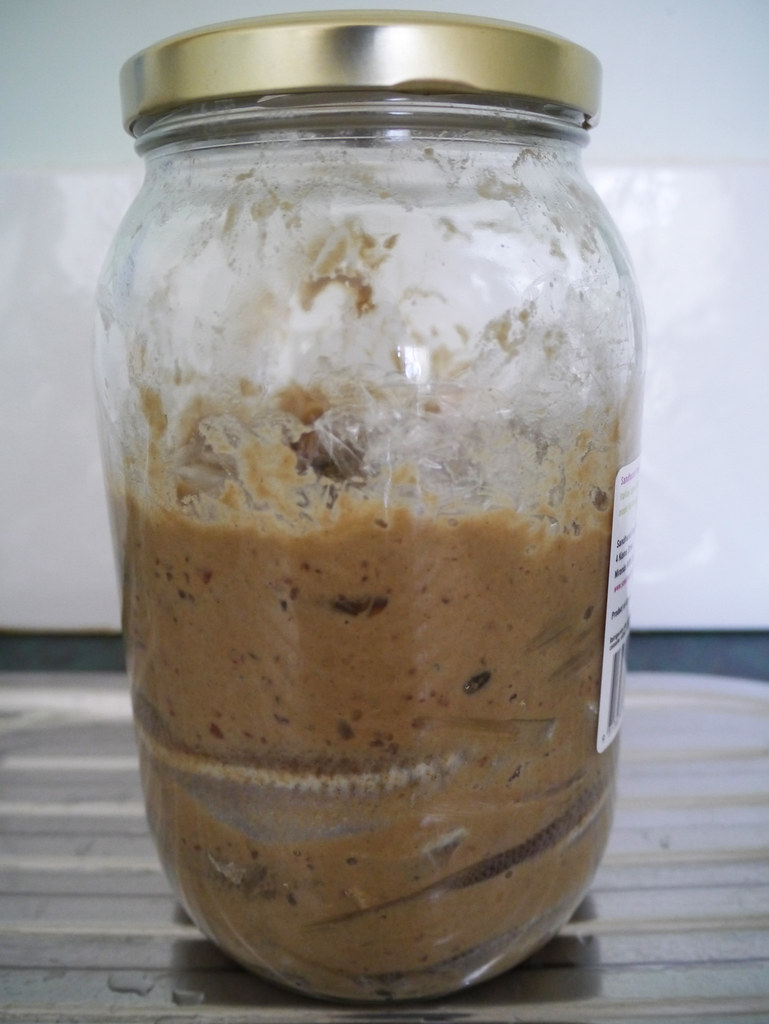
A jar of just made padaek ready for fermentation.
Note: This padaek recipe is an experiment and a work in progress.There are other padaek recipes mentioned in this post that you can consider.
~
What is padaek?
[dropcap]Padaek[/dropcap] (paa-dëëk) (Lao: ປາແດກ) (also known as padek and Lao bagoong) is traditional Lao fermented fish sauce. It’s a quintessential Lao ingredient and condiment. Padaek is a seasoned and thicker fish sauce compared to regular fish sauce and it often contains chunks of fish in it. It’s typically pungent in taste and smell, and opaque in colour. It’s funky/rich aroma is akin to cheeses like Époisses. 1 Some Lao cooks would agree that padaek is the lifeblood of Lao cuisine.
Owing to the landlocked nature of the former kingdom of Lan Xang, padaek is traditionally made from freshwater fish sourced from the Mekong River. When it is ready for consumption, padaek can be eaten as it is, or used in a variety of Lao dishes. Padaek sauce is customarily used to make “tum mark hoong” (Lao spicy green papaya salad) and “jeow” (Lao relishes/sauces). It is also an essential ingredient in central and northern Thailand, and the Isan province, which is home to many Lao descendants.
The aroma of padaek is intense, and it can be so intoxicating that it can encapsulate a room and linger. Despite its famous odour though, when the correct amount of padaek is added to a Lao recipe, the sauce magically transforms the dish, adding a sublime depth of flavour that is rich in umami, not replicable by regular fish sauce. 2

Sardines was another option for me to make padaek with – they’re a good size for pickling in jars, but they just looked a little too oily for the job. The fishmonger said that he preferred the taste of the red spot whiting compared to the sardines, and that helped seal the deal.
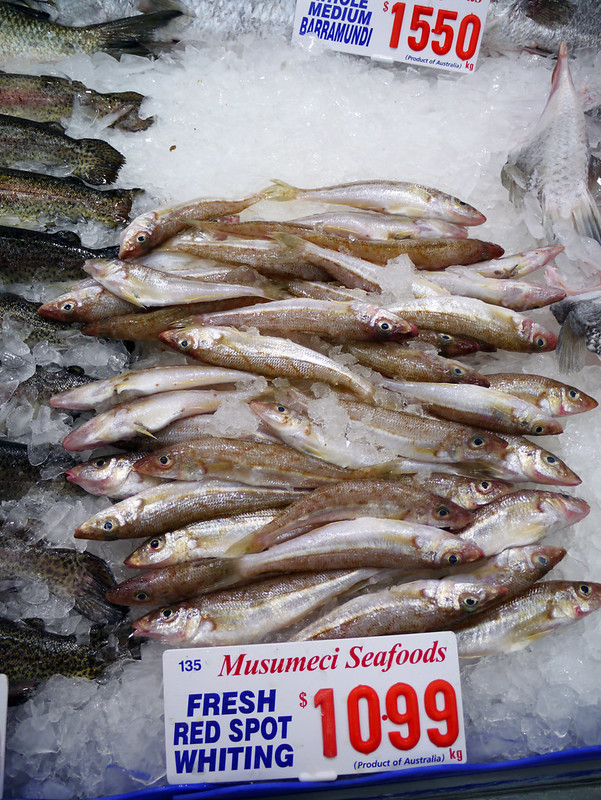
I found two types of fish at the fish markets that I thought would be good to make padaek with; red spot whiting (Sillago flindersi) and sardines. I decided to use smaller fish because I’m using a 2kg glass jar and I wanted to keep the fish whole and not cut them up. I chose red spot whiting because of their size, colour and non-oily qualities. Red spot whiting are a great eating fish and they’re available all yer round. “They have a delicate, sweet flavour, low oiliness and moist, medium-textured, flaky flesh with fine bones, which are easily removed. The edible skin can be left on and the bones make excellent stock. They’re endemic to the east coast of Australia.” Reference: http://www.sydneyfishmarket.com.au.
In this post, I will share with you my process in making padaek, based on several recipes that I’ve found online. This is my first attempt at making padaek and I’m not even sure how it will turn out. The fermentation process takes a long time (6 months to 1 year), and I won’t be able to tell what it tastes like for at least another year.
Padaek recipes online:
The padaek recipes I’ve found online include the following. If you know of any other padaek recipes or variations to it, please let me know.
- Ting’s padaek recipe based on her mother’s recipe that uses smelt at Playing with Food.
- A ‘Padaek – Lao Fermented Fish Sauce’ recipe at Cooking Software Australia.
- Boutsady Khounnouvong’s padaek recipe at Food From Northern Laos.
- Madame Ny Luangkhot padaek recipe at Food From Northern Laos.
- A padaek recipe by the Kalom (Tai Yuan) people from Luang Namtha, also at Food From Northern Laos.
All of the above recipes share three ingredients essential to make padaek; fish, salt and rice bran. The ratio of these ingredients and the methods vary slightly in the recipes (depending on the size of fish, for example). It is interesting to note that the padaek recipe by the Kalom (Tai Yuan) people include the addition of galangal, chilies and alcohol. 3
Before we start, I would like to share with you a poem, titled “Padaek” by award-winning Laotian American writer Bryan Thao Worra.
Padaek:
Speak to me of padaek
And some poor ba ferments, pungent, chunky and spicy.
Alas, so unlikely to catch on like sriracha or sushi,
At least in this century.
I look at your lips, appreciatively pondering
All that has passed beyond those lovely gates for your jai ngam lai,
Where even the last bit of fish is not forgotten or left behind.
Isn’t it a beautiful/wonderful poem‽ For more of Bryan’s wonderful poems, you can read some of them here, and to learn more about his writing, you can read his blog here.
My padaek making process:
I created the following recipe, based on the padaek recipes above. I wanted to make my padaek as authentic to the padaek in Laos as possible by using river fish (eg: redfin perch), however, I was not successful in finding any suitable river fish for sale. Next time though, I think I will just have to catch some river fish instead. Anyhow, I’m very happy with the fish that I found and chose – red spot whiting; which are a great eating fish and look perfect to make padaek with.

Ingredients that you’ll need to make padaek are fish, salt and rice bran.

Out of all the ingredients, rice bran was the most difficult for me to obtain. I searched at the breakfast/cereal and health food section at our local Woolies, to no avail. There were wheat bran and oat bran, but no rice bran to be found. I went to our local Asian grocer and heath food store as well but alas, they could not help me there either. I almost gave up and thought about substituting the rice bran with wheat or oat bran, until I called another health food store, Mrs Watson’s, whom magically had rice bran available with about an hour until closing time. We scooted there in time, and I mentioned to the shopkeeper that I thought about using wheat or oat bran for my padaek sauce. She said the wheat or oat bran would make the sauce go gluggy, however, Ting used wheat bran in her recipe, and the after 1 month photo looked good and not gluggy at all. Anyhow, I purchased the rice bran, which looks a lot different (finer) compared to wheat or oat bran (flaky).
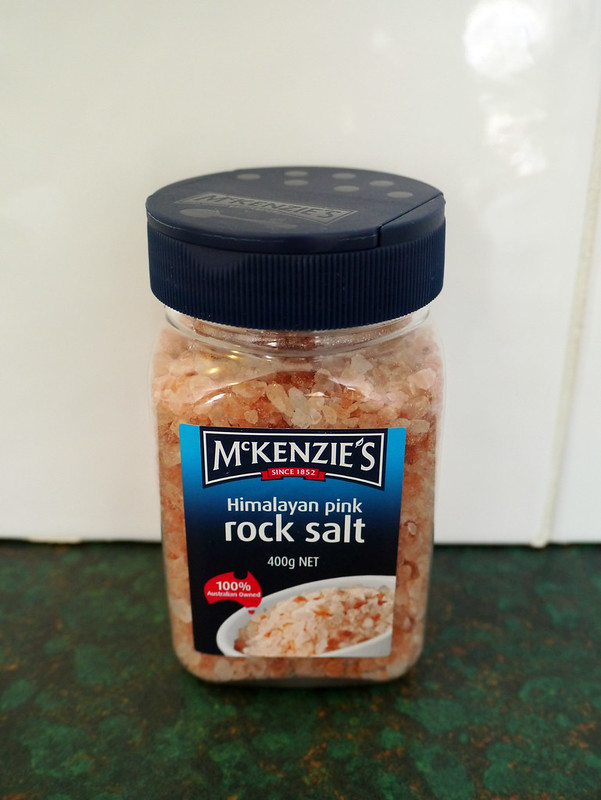
“Himalayan Pink Rock Salt has a rich mineral content that includes over 84 minerals and trace elements with a range of health benefits. It was originally formed from marine fossil deposits over 250 million years ago during the Jurassic era.” I have a weakness for good marketing material and after reading the blurb on the back, I knew I had to try it. I just love the pink/salmon/apricot colour of the rock salt. Hopefully, it will give my padaek a wonderful element and character.
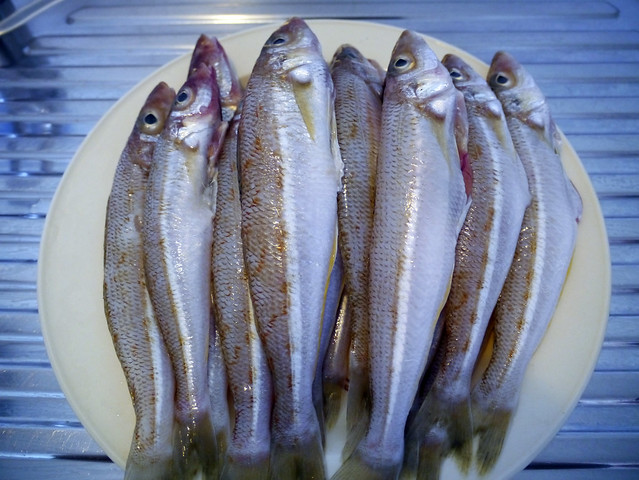
First, prepare the fish – wash, clean and gut them, depending on the type and size of fish. If you’re using larger fish, you might want to cut them into smaller pieces. For the whiting, I simply washed them, scaled them and gutted them. I removed the poo/intestines but left the other innards intact, including the gills. I also left the heads and fins intact. These components should add to the padaek flavour, right?
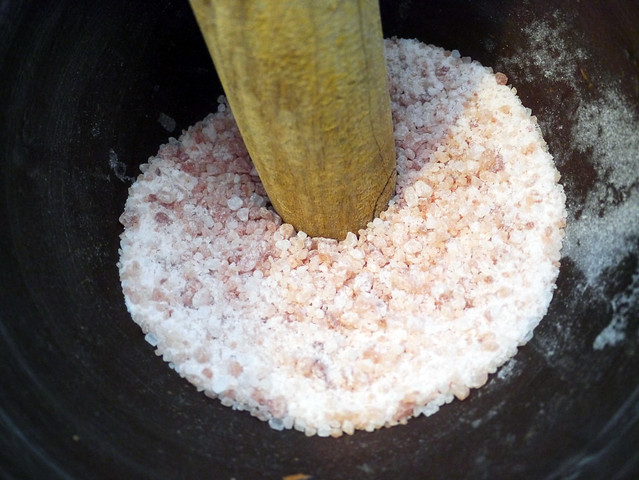
I thought that the rock salt were too large/rocky for the recipe and was worried that they might not work properly in the fermentation process, resulting in an unsuccessful padaek sauce. So, I pounded 250 grams of the rock salt with the ‘kok’ and ‘sark’ until the salt was finer. Next time, I think I will use salt flakes or finer salt instead.
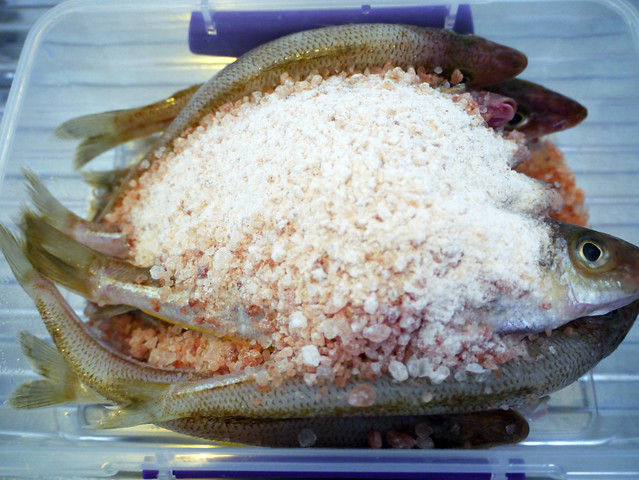
Place the drained cleaned fish into a large bowl/container and add the salt. Mix the fish and salt together, thoroughly and carefully. Be sure to squeeze, knead and blend them all together very well.
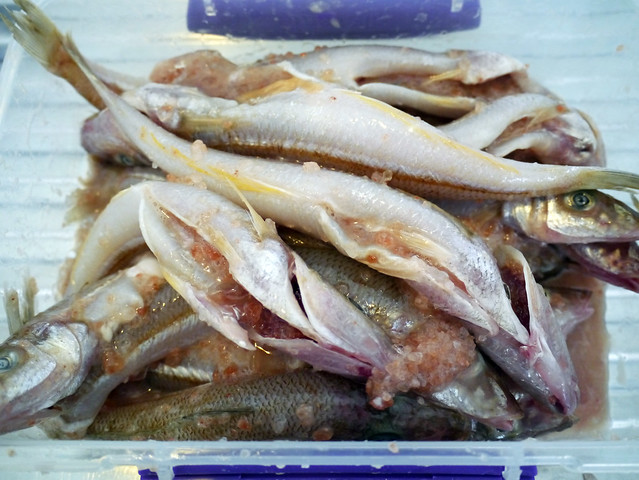
When mixing the fish and salt together with your hands, be careful of the fins and other sharp bits of the fish. Ensure that the salt is well mixed into the fish and press the salt into the gut and head cavities.

After you’ve mixed the fish and salt together thoroughly, cover them up with a lid and leave to rest for 12 hours (overnight), as advised in this recipe, in the fridge.
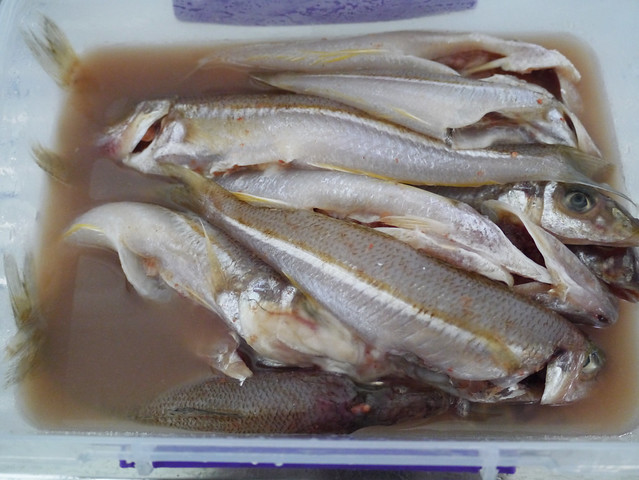
Tra-da! After 12 hours of resting in the fridge, a surprising amount of fish/salt mix liquid had formed.
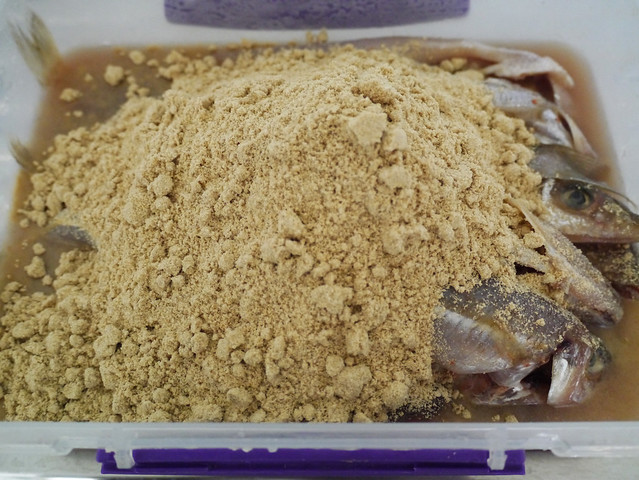
Add 250 grams of rice bran and mix all three ingredients together thoroughly in the same manner as before.

Make sure the rice bran, which has turned into an earthy/clay coloured paste by this stage, is thoroughly mixed through. Ensure that the rice brand/salt mixture is pushed into the fish cavities.
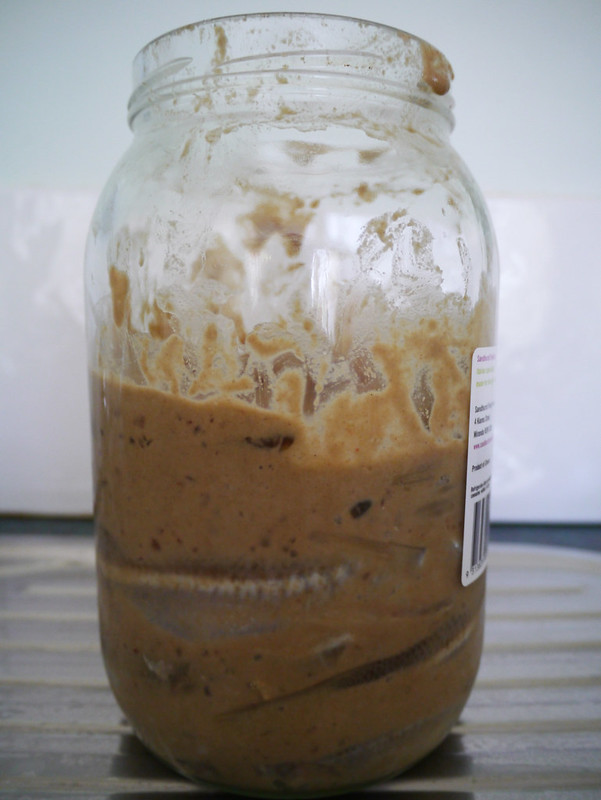
Transfer the mixed fish (and the rice bran/salt mixture) into a glass jar. I used a recycled 2kg olive glass jar which is a perfect size for 1kg of fish. I have read that you can also use pottery/ceramic jars to store the fish in for fermentation, but I couldn’t find a pottery jar with a tight enough seal, and I didn’t want to take any risks for the fermentation to not work properly, so I used the glass jar instead.
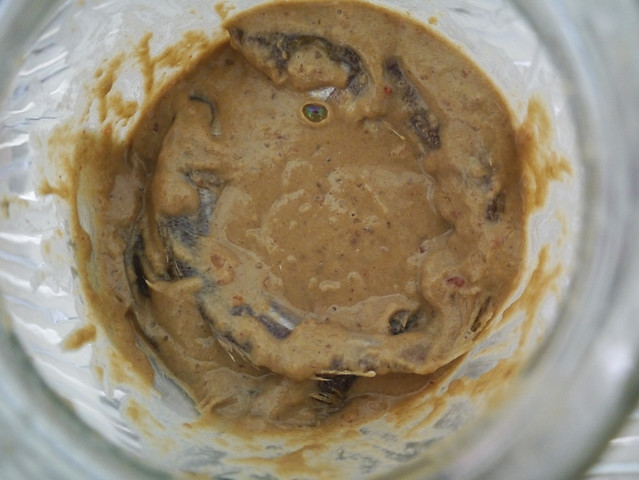
Once the fish mix/mixture is placed into the jar, use your hand to press down the contents so that it is firm. Be careful to not fill the jar completely. I have read that I should leave at least 7-8 cms at the top, as there will be expansion with fermentation. The 2kg glass jar provided more than adequate vacant top space. By this time, an air bubble had formed at the top of the mixture which presented an opportunity for me to take an arty air bubble reflection self portrait.
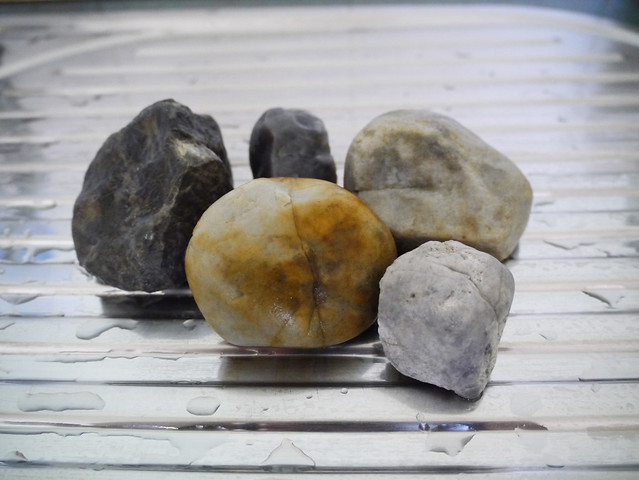
Washed, scrubbed and boiled lake stones, ready to be used as weight on top of the fish.
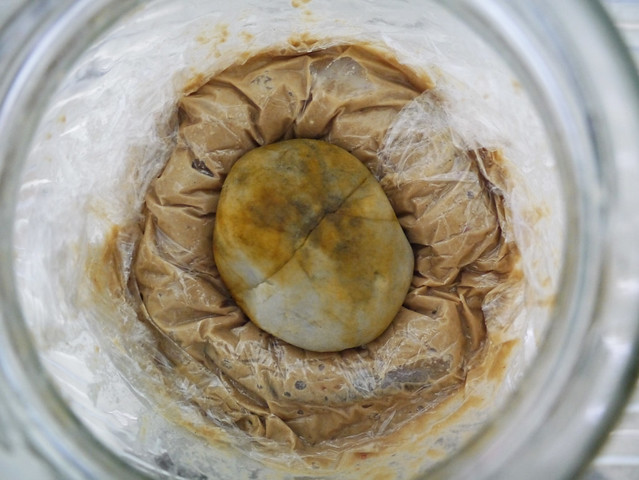
Cover the fish mix/brew with a couple of layers of cling wrap, and then place a boiled rock/stone on top of the cling wrap to maintain pressure on the fish. Screw the lid back on the glass jar and voila!! You have yourself, a beautiful jar of padaek fish mix ready for heavenly fermentation. Let your magical brew sit and ferment in a cool dry place, perhaps in a cool kitchen cupboard. Remember, hot air rises. I’ve read that you should leave the mix to ferment for at least six months, a year is preferable. During the fermentation, remember to check the mixture. Use a large spoon to turn the fish inside the jar occasionally and press them down again. I have read that the padaek will keep in their jars for two years, perhaps, even longer if it’s a good brew or kept refrigerated? Store your padaek carefully because flies love it, and it could cause a nightmare if dropped! Imagine that.
- 1 kg of fresh fish (non-oily fish is recommended)
- 250 grams of salt
- 250 grams of rice bran
- First, prepare the fish. Wash, clean and gut them, depending on the type and size of fish. If you’re using larger fish, you might want to cut them into smaller pieces.
- Place the drained cleaned fish into a large bowl/container and add the salt. Mix the fish and salt together, thoroughly and carefully. Be sure to squeeze, knead and blend them all together very well.
- Ensure that the salt is well mixed into the fish and press the salt into the gut and head cavities.
- Cover the fish/salt mix with a lid and leave to rest for 12 hours (overnight) in the fridge.
- After 12 hours of resting in the fridge, add 250 grams of rice bran and mix all three ingredients together thoroughly in the same manner as before.
- Ensure that the rice brand/salt mixture is pushed into the fish cavities.
- Transfer the mixed fish (and the rice bran/salt mixture) into a glass jar. I used a recycled 2kg olive glass jar which is a perfect size for 1kg of fish.
- Once the fish mix/mixture is placed into the jar, use your hand to press down the contents so that it is firm. Be careful to not fill the jar completely. Leave at least 7-8 cms at the top, as there will be expansion with fermentation. A 2kg glass jar should provide more than adequate vacant top space.
- Cover the fish mix/brew with a couple of layers of cling wrap.
- Place a cleaned/washed/boiled river stone in a small zip-lock bag and place it on top of cling wrap layer, on top of the fish.
- Screw the lid back on the glass jar.
- Store your jar of padaek in a cool dry place, perhaps in a cool kitchen cupboard. Remember, hot air rises.
- Leave the mix to ferment for at least six months, a year is preferable.
- During the fermentation, remember to check the mixture. Use a large spoon to turn the fish inside the jar occasionally and press them down again. I have read that the padaek will keep in their jars for two years, perhaps, even longer if it’s a good brew or kept refrigerated? Store your padaek carefully because flies love it, and it could cause a nightmare if dropped!
1 large glass jar (with sealable lid) to store and ferment the padaek in
1 cleaned/washed/boiled river stone
1 small zip-lock bag
cling wrap
In retrospect:
Looking back at my process in making padaek for the first time, there are a few things that I would like to make notes of.
- I am worried that I did not pound the rock salt fine enough and the fermentation process will be affected. Next time, I will pound the rock salt finer or use salt flakes instead.
- To prevent my hands from smelling fishy for the next 2-3 hours; next time, I will wear plastic gloves when mixing the fish with the salt and rice bran. I will also make sure that my kitchen is well ventilated, to prevent it from smelling fishy.
- I think that mixing the salt with the fish first and then letting it rest overnight before adding the rice bran was good idea. I believe that this helps cure and soften the fish so that the rice bran can work more effectively? However, this method resulted in excess fish liquid and a gluey paste/mixture when the rice bran was added (as you can see in the photos above). This is of concern to me. I have to wait and see if this gluey consistency is correct/ok, and what effects it has on the padaek.
That’s all folks! Only time will tell if my process is successful. I will keep you posted with photo updates in 1 month’s time. Please pray with me.
Ingredients you’ll need:
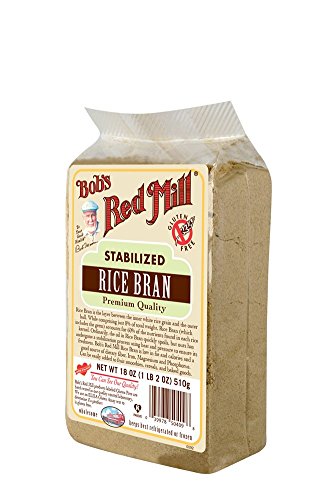
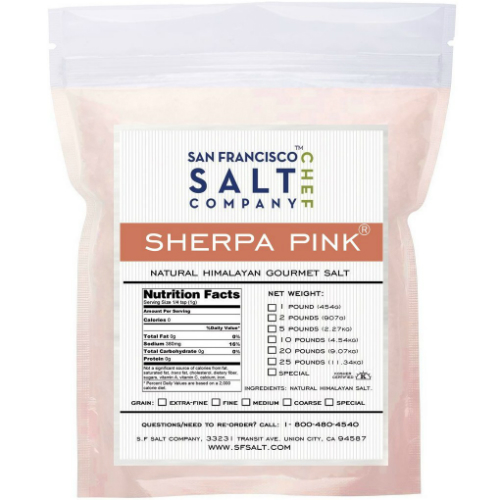
Did you know?
- Padaek is a rich source of umami. Umami is identified as the fifth taste. In Lao, the word for umami is “nua”. 4
- Rice bran is the layer between the inner white rice grain and the outer hull. In Lao, the word for rice bran is “hum”.
Update 06/01/14:

Overnight, I decided to open the tightly sealed lid and removed the stone and cling wrap from inside the jar. I placed and sealed the stone in a small zip-lock bag, before placing it back on a new double layer of cling wrap, on top of the fish. I thought that this would be a better/healthier method because I don’t like the idea of the stone being submerged in the padaek liquid with the fish during fermentation. Next time, I think it is a wise idea to have the stone sealed in a zip-lock bag before placing it on top of the cling wrap and fish, from the beginning. I re-screwed the lid back on and replaced the jar back into the cool cupboard for it to ferment. Now, let’s hope this works!
Update 05/09/14:
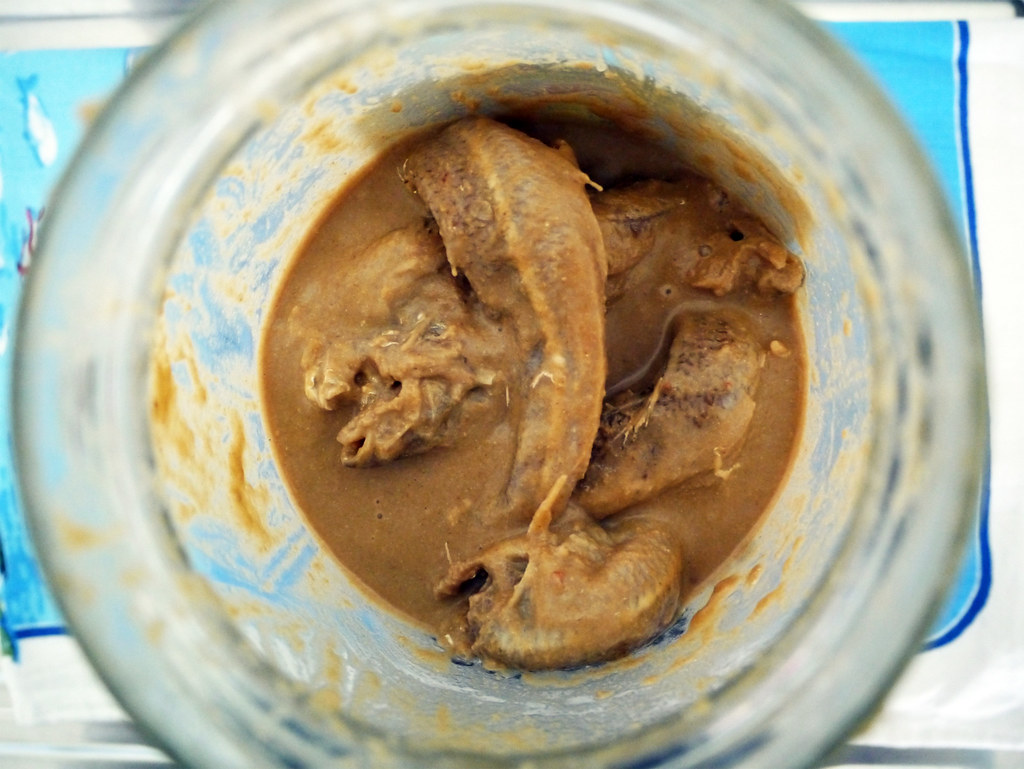
Padaek #8
Notes:
- Reference: http://cookingsoftware.com.au. ↩
- Reference: http://cookingsoftware.com.au, http://tingplayingwithfood.blogspot.com. ↩
- Reference: http://www.foodfromnorthernlaos.com. ↩
- For more info on umami, read this post. ↩
